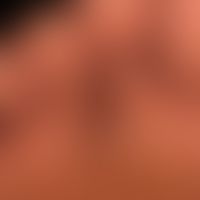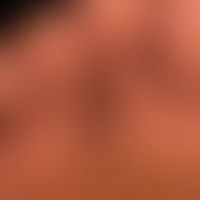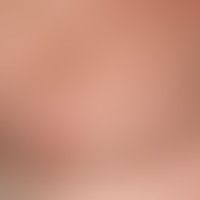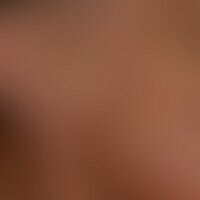Image diagnoses for "black"
81 results with 226 images
Results forblack

Thrombangiitis obliterans I73.1
Thrombangiitis obliterans. 32-year-old patient with a nicotine abuse lasting for years and spotted plantar rythema existing since 6 months as well as mummified toe cap necroses (detailed picture).

Nail hematoma T14.05
Hematoma, nail hematoma: growing nail hematoma . left initial situation, right 8 weeks later. note: the nail matrix shows no discoloration at the cutting edge (marked by arrows)!

Pemphigus vulgaris L10.0
pemphigus vulgaris: recurrent clinical picture for months. superficially, weeping, non-detachable (because painful) crusts are found on weeping surfaces. no clinically detectable blisters. at the same time, extensive erosions of the oral mucosa. on searching inspection of the skin, very isolated, easily injured (immediately bursting) blisters can be found (here in this picture on the patient's left shoulder)

Melanoma acrolentiginous C43.7 / C43.7
Melanoma, malignant, acrolentiginous: a slow-growing, previously asymptomatic, multicentric hyperpigmentation that has been present for many years; for about 1 year, increasing nodule formation with a tendency to bleed.

Melanoma acrolentiginous C43.7 / C43.7
Melanoma, malignant, acrolentiginous: a slow-growing, previously asymptomatic hyperpigmentation that has existed for many years.

Melanoma cutaneous C43.-
Melanoma malignes acrolentiginous: permanently growing asymmetric irregularly coloured completely asympotmatic spot that has existed for years.

Naevus melanocytic congenital bathing trunks D22.L
Nevus melanocytic congenital bathing suit type: large-area congenital melanocytic nevus with multiple satellite nevi.

Nail hematoma T14.05
Differential diagnosis of "nail hematoma": All melanocytic neoplasms of the nail matrix lead to striped pigmentation of the nail plate.

Thrombangiitis obliterans I73.1
Thrombangiitis obliterans: 48-year-old female patient; decades of nicotine abuse. 12 months of acrozynosis (even more severe in cool surroundings) and mummified fingertip necrosis with osteolysis.

Melanoma cutaneous C43.-
Melanoma malignes: multiple cutaneous melanoma metastases in pre-operated nodular melanoma of the lower leg.

Melanoma acrolentiginous C43.7 / C43.7
DD: Melanoma malignes acrolentiginous: here: complicating onychomycosis with bleeding due to mold infestation; the inlet points proximally, a normally colored nail area; no Hutchinson phenomenon.

Pediculosis (overview) B85.2
Pediculosis corporis: conspicuous black, non-strippable "dots" on the hair shafts.

Pediculosis (overview) B85.2
Pediculosis corporis: Nits visible as black dots, here marked with arrows.

Erythema multiforme, minus-type L51.0
erythema multiforme: recurrent exanthema with cocard-like plaques for several years. the skin changes occurred shortly after the appearance of a herpes simplex labialis. figure with healing phase of the herpes simplex infection.

Melanonychia striata L60.8
Striped black coloration of the big toe nail. The finding is unchanged since > 1 year. Here striped onychomycosis due to mold infestation of the nail. Diagnostic evidence is the normally colored proximal stripe above the nail dyschromia (see explanatory figure and reflected light microscopy).

Atopic dermatitis (overview) L20.-
Generalized atopic eczema: large-area, chronic. generalized seizure-like itchy dermatitis with multiple, symmetrical, blurred, light grey, rough, flat plaques as well as flat, dry scaling, grey-brown spots in a 22-year-old female patient.

Angiokeratoma circumscriptum D23.L
Angiokeratoma corporis circumscriptum: extensive, linear (following the Blaschko lines), non-syndromal, mixed capillary/venous malformation with verrucous plaques and nodules. initial manifestation in early childhood. continuous growth since then. image as partial manifestation of an extensive finding affecting the leg over its entire length.

Angiokeratoma circumscriptum D23.L
Angiokeratoma corporis circumscriptum: extensive, lnear (following the Blaschko lines), non-syndromal mixed capillary/venous malformation with verrucous plaques and nodules. First manifestation in early childhood, continuous growth since then.

Elastoidosis cutanea nodularis et cystica L57.8
Elastoidosis cutanea nodularis et cystica: multiple, chronic inpatient, 0.2-0.4 cm large, symptomless, black papules (comedones) and yellow papules and nodules. 72-year-old man with massive chronic UV exposure over decades.

Elastoidosis cutanea nodularis et cystica L57.8
Elastoidosis cutanea nodularis et cystica: multiple, chronic inpatient, symptom-free, black comedones (see periorbital region) as well as soft, yellowish papules and nodules. 72-year-old man with massive chronic UV exposure over decades.

Angiosarcoma of the head and face skin C44.-
Angiosarcoma of the head and facial skin: the 69-year-old patient noticed this rapidly growing and recurrently bleeding 3x5 cm large, little symptomatic node around the capillitium for 6 months. After incomplete preliminary surgery within a few weeks formation of the present recurrent node. The inconspicuous erythema around the node is noticeable. After the micrographically controlled surgery, the tumor was only free of tumor after an approximately 10 x 10 cm large excision.

Angiosarcoma of the head and face skin C44.-
Angiosarcoma of the head and facial skin: the 69-year-old patient noticed this rapidly growing and recurrently bleeding 3x5 cm large, little symptomatic node around the capillitium for 6 months. After incomplete preliminary surgery within a few weeks formation of the present recurrent node. The inconspicuous erythema around the node is noticeable. After the micrographically controlled surgery, the tumor was only free of tumor after an approximately 10 x 10 cm large excision.


